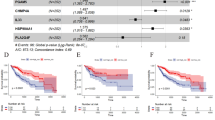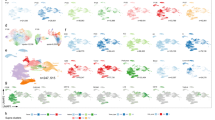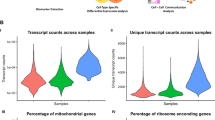Abstract
Previous research has demonstrated that the conversion of hepatocellular carcinoma (HCC) to intrahepatic cholangiocarcinoma (iCCA) can be stimulated by manipulating the tumor microenvironment linked with necroptosis. However, the specific cells regulating the necroptosis microenvironment have not yet been identified. Additionally, further inquiry into the mechanism of how the tumor microenvironment regulates necroptosis and its impact on primary liver cancer(PLC) progression may be beneficial for precision therapy. We recruited a single-cell RNA sequencing dataset (scRNA-seq) with 34 samples from 4 HCC patients and 3 iCCA patients, and a Spatial Transcriptomic (ST) dataset including one each of HCC, iCCA, and combined hepatocellular-cholangiocarcinoma (cHCC-CCA). Quality control, dimensionality reduction and clustering were based on Seurat software (v4.2.2) process and batch effects were removed by harmony (v0.1.1) software. The pseudotime analysis (also known as cell trajectory) in the single cell dataset was performed by monocle2 software (v2.24.0). Calculation of necroptosis fraction was performed by AUCell (v1.16.0) software. Switch gene analysis was performed by geneSwitches(v0.1.0) software. Dimensionality reduction, clustering, and spatial image in ST dataset were performed by Seurat (v4.0.2). Tumor cell identification, tumor subtype characterization, and cell type deconvolution in spot were performed by SpaCET (v1.0.0) software. Immunofluorescence and immunohistochemistry experiments were used to prove our conclusions. Analysis of intercellular communication was performed using CellChat software (v1.4.0). ScRNA-seq analysis of HCC and iCCA revealed that necroptosis predominantly occurred in the myeloid cell subset, particularly in FCGBP + SPP1 + tumor-associated macrophages (TAMs), which had the highest likelihood of undergoing necroptosis. The existence of macrophages undergoing necroptosis cell death was further confirmed by immunofluorescence. Regions of HCC with poor differentiation, cHCC-CCA with more cholangiocarcinoma features, and the tumor region of iCCA shared spatial colocalization with FCGBP + macrophages, as confirmed by spatial transcriptomics, immunohistochemistry and immunofluorescence. Pseudotime analysis showed that premalignant cells could progress into two directions, one towards HCC and the other towards iCCA and cHCC-CCA. Immunofluorescence and immunohistochemistry experiments demonstrated that the number of macrophages undergoing necroptosis in cHCC-CCA was higher than in iCCA and HCC, the number of macrophages undergoing necroptosis in cHCC-CCA with cholangiocarcinoma features was more than in cHCC-CCA with hepatocellular carcinoma features. Further investigation showed that myeloid cells with the highest necroptosis score were derived from the HCC_4 case, which had a severe inflammatory background on pathological histology and was likely to progress towards iCCA and cHCC-CCA. Switchgene analysis indicated that S100A6 may play a significant role in the progression of premalignant cells towards iCCA and cHCC-CCA. Immunohistochemistry confirmed the expression of S100A6 in PLC, the more severe inflammatory background of the tumor area, the more cholangiocellular carcinoma features of the tumor area, S100A6 expression was higher. The emergence of necroptosis microenvironment was found to be significantly associated with FCGBP + SPP1 + TAMs in PLC. In the presence of necroptosis microenvironment, premalignant cells appeared to transform into iCCA or cHCC-CCA. In contrast, without a necroptosis microenvironment, premalignant cells tended to develop into HCC, exhibiting amplified stemness-related genes (SRGs) and heightened malignancy.









Similar content being viewed by others
Data availability
The ScRNA-seq datasets generated during the current study are available in the GEO database (https://www.ncbi.nlm.nih.gov/geo/query/acc.cgi?acc=GSE189903). The ST datasets generated during the current study are available in the Genome Sequence Archive database (https://ngdc.cncb.ac.cn/gsa-human/browse/HRA000437).
Abbreviations
- scRNA-seq:
-
Single-cell RNA sequencing
- ST:
-
Spatial transcriptome
- PLC:
-
Primary liver cancer
- HCC:
-
Hepatocellular carcinoma
- iCCA/ICC:
-
Intrahepatic cholangiocarcinoma
- CNV:
-
Copy number variation
- TCGA:
-
The cancer genome atlas
- TAM:
-
Tumor-associated macrophage
- CAF:
-
Cancer associated fibroblasts
- TIB:
-
Tumor immune barrier
- LAM:
-
Lipid associated macrophages
- TAME:
-
Tumor-adipose microenvironment
- SRG:
-
Stemness-related gene
- GEO:
-
Gene expression omnibus
- HE:
-
Hematoxylin–eosin staining
References
Bray F, Ferlay J, Soerjomataram I, Siegel RL et al (2018) Global cancer statistics 2018: GLOBOCAN estimates of incidence and mortality. CA Cancer J Clin 68(6):394–424
Marquardt JU, Andersen JB, Thorgeirsson SS (2015) Functional and genetic deconstruction of the cellular origin in liver cancer. Nat Rev Cancer 15(11):653–667
Xue R, Chen LU, Zhang C et al (2019) Genomic and transcriptomic profiling of combined hepatocellular and intrahepatic cholangiocarcinoma reveals distinct molecular subtypes. Cancer Cell 35(6):932–947
Liu Y, Zhuo S, Zhou Y, Ma L et al (2022) Yap-Sox9 signaling determines hepatocyte plasticity and lineage-specific. J Hepatol 76(3):652–664
Fan B, Malato Y, Calvisi DF, Naqvi S et al (2012) Cholangiocarcinomas can originate from hepatocytes in mice. J Clin Invest 122(8):2911–2915
Sekiya S, Suzuki A (2012) Intrahepatic cholangiocarcinoma can arise from Notch-mediated conversion of. J Clin Invest 122(11):3914–3918
Wang J, Wang H, Peters M, Ding N et al (2019) Loss of Fbxw7 synergizes with activated Akt signaling to promote c-Myc dependent. J Hepatol 71(4):742–752
Hill MA, Alexander WB, Guo B et al (2018) Kras and Tp53 mutations cause cholangiocyte-and hepatocyte-derived cholangiocarcinoma. Cancer Res 78(16):4445–4451
Brunt E, Aishima S, Clavien PA, Fowler K et al (2018) cHCC-CCA: Consensus terminology for primary liver carcinomas with both. Hepatology 68(1):113–126
Guo Y, Long J, Lei S (2019) Promoter methylation as biomarkers for diagnosis of melanoma: a systematic review and meta-analysis. J Cell Physiol 234(5):7356–7367
Li L, Che L, Tharp KM, Park HM et al (2016) Differential requirement for de novo lipogenesis in cholangiocarcinoma and. Hepatology 63(6):1900–1913
Carlson CM, Frandsen JL, Kirchhof N, McIvor RS et al (2005) Somatic integration of an oncogene-harboring sleeping beauty transposon models. Proc Natl Acad Sci U S A 102(47):17059–17064
Chang Y, Jeong SW, Young Jang J, Jae Kim Y (2020) Recent updates of transarterial chemoembolilzation in hepatocellular carcinoma. Int J Mol Sci 21(21):8165
Louis DN, Perry A, Reifenberger G et al (2016) The 2016 World Health Organization classification of tumors of the central nervous system: a summary. Acta Neuropathol 131:803–820
Degterev A, Huang Z, Boyce M, Li Y et al (2005) Chemical inhibitor of nonapoptotic cell death with therapeutic potential for. Nat Chem Biol 1(2):112–119
Sprooten J, De Wijngaert P et al (2020) Necroptosis in immuno-oncology and cancer immunotherapy. Cells 9(8):1823
Yan J, Wan P, Choksi S, Liu ZG (2022) Necroptosis and tumor progression. Trends Cancer 8(1):21–27
Dhuriya YK, Sharma D (2018) Necroptosis: a regulated inflammatory mode of cell death. J Neuroinflammation 15(1):1–9
Wang H, Sun L, Su L, Rizo J et al (2014) Mixed lineage kinase domain-like protein MLKL causes necrotic membrane disruption. Mol Cell 54(1):133–146
Orozco SL, Daniels BP, Yatim N, Messmer MN et al (2019) RIPK3 activation leads to cytokine synthesis that continues after loss of cell. Cell Rep 28(9):2275–2287
Seehawer M, Heinzmann F et al (2018) Necroptosis microenvironment directs lineage commitment in liver cancer. Nature 562(7725):69–75
Nagtegaal ID, Odze RD, Klimstra D, Paradis V et al (2020) The 2019 WHO classification of tumours of the digestive system. Histopathology 76(2):182–188
Ma L, Heinrich S, Wang L et al (2022) Multiregional single-cell dissection of tumor and immune cells reveals stable lock-and-key features in liver cancer. Nat Commun 13(1):7533
Chu X, Zhang Y, Cheng S (2022) Heterogeneity of tumor-infiltrating myeloid cells in era of single-cell genomics. Chin J Cancer Res 34(6):543–553
Park JW, Kang J et al (2021) The prognostic significance of p16 expression pattern in diffuse gliomas. J Pathol Trans Med 55(2):102–111
Wu R, Guo W, Qiu X et al (2021) Comprehensive analysis of spatial architecture in primary liver cancer. Sci Adv 7(51):eabg3750
Liu Y, Xun Z, Ma K, Liang S et al (2023) Identification of a tumour immune barrier in the HCC microenvironment that. J Hepatol 78(4):770–782
Ally A, Balasundaram M et al (2017) Comprehensive and integrative genomic characterization of hepatocellular carcinoma. Cell 169(7):1327–1341
Fernandez-Banet J, Lee NP, Chan KT, Gao H et al (2014) Decoding complex patterns of genomic rearrangement in hepatocellular carcinoma. Genomics 103(2–3):189–203
Murata K, Jadhav U, Madha S, van Es J et al (2020) Ascl2-dependent cell dedifferentiation drives regeneration of ablated intestinal. Cell Stem Cell 26(3):377–390
Stelzer G, Rosen N, Plaschkes I, Zimmerman S et al (2016) The genecards suite: from gene data mining to disease genome sequence analyses. Curr Protoc Bioinformatics 54(1):1–1
Kayagaki N, Kornfeld OS et al (2021) NINJ1 mediates plasma membrane rupture during lytic cell death. Nature 591(7848):131–136
Degen M, Orcid Id, Santos JC, Orcid Id et al (2023) Structural basis of NINJ1-mediated plasma membrane rupture in cell death. Nature 17(10):023–05991
Zhou C, Lu X, Wang Y, Qian X et al (2022) Histopathological components correlated with MRI features and prognosis in. Eur Radiol 32(10):6702–6711
Zhang X, Ji L, Li MO (2023) Control of tumor-associated macrophage responses by nutrient acquisition and metabolism. Immunity 56(1):14–31
Liu Z, Gao Z, Li B, Li J et al (2022) Lipid-associated macrophages in the tumor-adipose microenvironment facilitate. Oncoimmunology 11(1):2085432
Cheng K, Orcid Id, Cai N, Zhu J et al (2022) Tumor-associated macrophages in liver cancer: From mechanisms to therapy. Cancer Commun 42(11):1112–1140
Zhang YL, Li Q, Yang XM, Fang F et al (2018) SPON2 promotes M1-like macrophage recruitment and inhibits hepatocellular. Cancer Res 78(9):2305–2317
Zong Z, Zou J, Mao R et al (2019) M1 macrophages induce PD-L1 expression in hepatocellular carcinoma cells through IL-1β signaling. Front Immunol 10:1643
Acknowledgements
We thank all the team members for their hard work and efforts.
Funding
This study is supported by Shenzhen Science and Technology Program (Grant No. JSGG20201102162802008) and the Key Program for Clinical Research at Peking University Shenzhen Hospital (LCYJZD2021007).
Author information
Authors and Affiliations
Contributions
CW designed and directed the study and wrote the manuscript. JC designed the study, performed the bioinformatics analysis and data generation, and wrote the original manuscript. WH was responsible for immunofluorescence experiment. LT and CC participated in writing review, editing, and funding acquisition. All authors read and approved the final manuscript.
Corresponding author
Ethics declarations
Conflict of interst
The authors declare that they have no competing interests.
Ethics approval and consent to participate
The samples used to perform the Immunofluorescence and immunohistochemistry were obtained from patients who gave informed consent and signed an informed consent form. The study was approved by the Ethical Review Committee of Peking University Shenzhen Hospital(PKUSZH)) (Approval Number: 2023115), and all experiments were performed inaccordance with the Declaration of Helsinki ethical guidelines.
Consent for publication
The authors declarethat they have no competing interests.
Additional information
Publisher's Note
Springer Nature remains neutral with regard to jurisdictional claims in published maps and institutional affiliations.
Supplementary Information
Below is the link to the electronic supplementary material.
Rights and permissions
Springer Nature or its licensor (e.g. a society or other partner) holds exclusive rights to this article under a publishing agreement with the author(s) or other rightsholder(s); author self-archiving of the accepted manuscript version of this article is solely governed by the terms of such publishing agreement and applicable law.
About this article
Cite this article
Wang, C., Chen, C., Hu, W. et al. Revealing the role of necroptosis microenvironment: FCGBP + tumor-associated macrophages drive primary liver cancer differentiation towards cHCC-CCA or iCCA. Apoptosis 29, 460–481 (2024). https://doi.org/10.1007/s10495-023-01908-3
Accepted:
Published:
Issue Date:
DOI: https://doi.org/10.1007/s10495-023-01908-3




